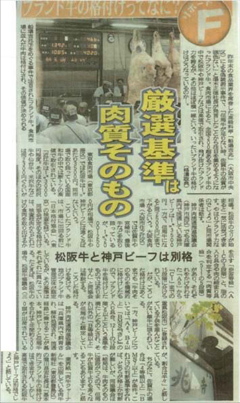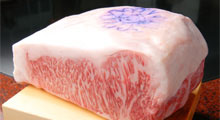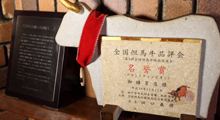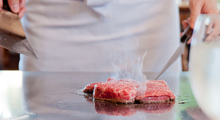Definition of Kobe Beef
Kobe Beef Cattle doesn't exist!?
You might be surprised at this unexpected title. In fact, if you travel around ranches in Kobe City or Hyogo Prefecture, or even Japan to seek for cattle named "Kobe Beef Cattle", you'll know it doesn't exist
Then, why is there a beef called Kobe Beef Cattle in restaurants? Actually, "Kobe Beef Cattle" is a kind of colloquial term in accordance with Matsusaka Beef Cattle/Omi Beef Cattle and the genuine name is called "Kobe Beef" or "Kobe meat". Also, we don't call the cattle born and bred in Kobe "Kobe Beef", either. There are only a few ranches in Kobe and even the cattle grow up within the site is not called "Kobe Beef".
As a matter of fact, there is a group named Kobe Meat Logistics Promotion consociation which was founded under cooperation of producers/edible meat logistics industry/consumers and the title of the highest-class beef, "Kobe Beef ""Kobe Meat" are given to only those that's cleared the strict definition set by this consociation.
That's why there is no innate "Kobe Beef Cattle" and "Kobe Beef Cattle" isn't used for describing the cattle bred in Kobe. Please keep in mind that Kobe Beef Cattle is a kind of colloquial term of "Kobe Beef", "Kobe Meat". It's a bit of trivia.
Kobe Beef's derivation
Kobe Beef that we explained about in "Kobe Beef Cattle doesn't exist!?" In fact the history is quite long, it extends back to the period from the end of Edo Period to the very beginning of Meiji Period. 「Kobe Meat Logistics Promotion Consociation 」
According to the official Home Page, on December 7th, Keio 3 (January 1st , 1868), which is 140 years back from now, Kobe became a first trade port in Japan and the opening ceremony was held. In those times, foreigners ate beef in Kobe and the good taste got known well. Since then, the beef has been appreciated as "Kobe Beef" and the name became worldwide. Eventually, what people looked forward to when coming to Japan was said "seeing its scenic lands and eating Kobe Beef". We heard.
Before long, Kobe's beautiful beef came to be introduced as "Kobe Beef" and was catching on as an international brand.
Looking into what happened in Keio 3(1868) further more, the transfer of power back to the Emperor was apparently done in that year. "Kobe Beef " gave its first cry in the very turbulent period. In the end of Edo period, did celebrities, who shined with the Meiji restoration, eat Kobe Beef?
Reference Data:
The transfer of power back to the Emperor was a political case in which the 15th Barbarian Subduing Generalissimo of Edo shogunate, Yoshinobu Tokugawa made an offer to transfer the sovereignty back to the imperial court on Nov. 9th, 1868 (Oct.14th ,Keio 3 in old calendar) in the end of Edo period. (quoted from free encyclopedia, "Wikipedia" )
Definition of Kobe Beef
We think now you understand "Kobe Beef Cattle" doesn't mean the cattle bred in Kobe. Then, what is Kobe Beef really like?
Concerning Tajima Beef Cattle
"Tajima Beef Cattle have been bred in Tajima Area since ancient times and they are written "suitable for cultivation, towing and food" in continuing series of Japan Chronicles. Before Edo Period, they were used for cultivating fields and transportation. They were actively bred in Tajima Area because of the long life, rebreeding performance and strong fertility and cattle market was begun in the Yabu Marketplace (now in Yabu City) and dealt up to then capital and areas around. Tajima Beef Cattle were in small size, powerful, and good in feedstuff efficiency, so they seemed to be popular.
After Meiji Period started and beef eating culture became widespread, they came to get people's attention as Kobe Beef. The name of Kobe Beef is said to be derived from some stories like that the beef that foreigners, who lived in the enclave of Kobe, obtained in Kobe and ate was tremendously tasty, like that the beef that foreigners, who lived in the enclave of Yokohama, obtained from Kansai Area, where people produced in a large quantity, always came through Kobe. In either way, that is believed Tajima Beef.
In Meiji Period, production of crossbreed with foreign breeds such as England growth, shorthorn Devon Breed or Switzerland growth, Brown Swiss Breed for breed improvement, but that caused worsening fleshy substance or lowering labor ability, so crossbreeding was canceled in a short while. In 1898 (Meiji 31), Cattle Registration List, which was like family registry, was applied to administer a bloodline of cattle and such cattle as crossbred with foreign growth were removed since 1911 (Meiji 44). Also, the cattle were never crossbred with other area growth breed varieties so that we could go ahead with the refinement of the bloodline and improvement and the lineage which called "Tsuru" was bred. There are 3 main Tsuru which are Atsuta-Tsuru, Fuki-Tsuru, Yoshi-Tsuru.
Tajima Beef Cattle are breeding cattle of brand Beef, such as Kobe Beef, Matsusaka Beef, Iga Beef, Omi Beef, Hida Beef due to its good quality and fleshy substance. Moreover, Tajima Beef Cattle are often used for breed improvement."
(quoted from free encyclopedia (Wikipedia) ) That's it.
Breeding Cattle of Kobe Beef/Kobe Meat are Tajima Beef Cattle.That means the origin of Kobe Beef is same as that of Matsusaka Beef, Iga Beef, Omi Beef, Hida Beef.
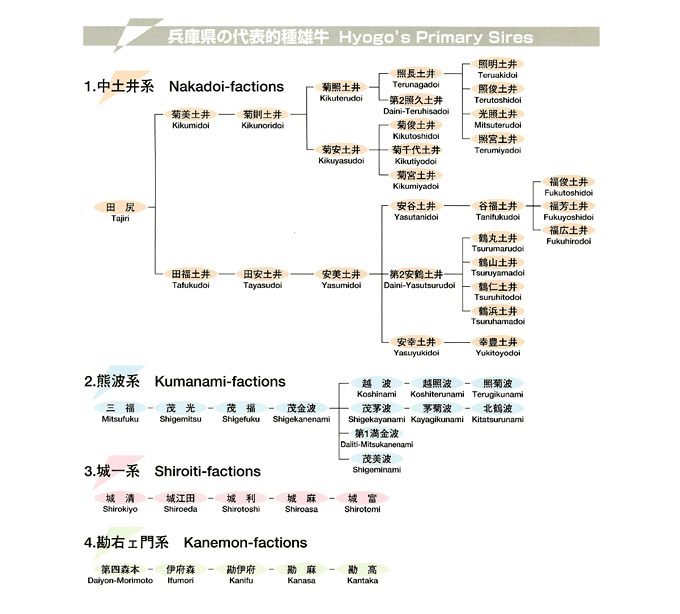
Among this Tajima Beef Cattle, The one
- ・of which "BMS", which is marbling percentage of fleshy substance, is over 6
- ・of which lean tissue's percentage is rank A or B
- ・of which weight of dressed carcass is under 450 kilograms
is defined as a Kobe Beef.
In short, only a handful of cattle from among the highest quality Tajima Beef Cattle, which fill the strict conditions, can be called "Kobe Beef".
Now you understand the absolute number is small because it's strictly selected.
The table below is called BMS(Beef marbling standard). Beef is ranked in the whole country based on this, the rating is determined by the degree of marbling in beef loin core. This represent only marbling, Fleshy substance or quality of the fat are related to the real taste than marbling.
To be called Kobe beef, BMS value of 6 to 12 are required. It is the lineage of the Tajima cow, and the proof of "the Kobe Beef" gets only a cow bred in Hyogo.



